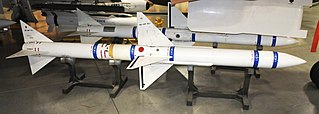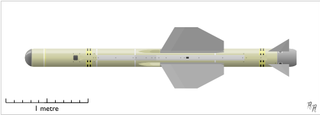Related Research Articles

The AIM-7 Sparrow is an American, medium-range semi-active radar homing air-to-air missile operated by the United States Air Force, United States Navy, and United States Marine Corps, as well as other various air forces and navies. Sparrow and its derivatives were the West's principal beyond visual range (BVR) air-to-air missile from the late 1950s until the 1990s. It remains in service, although it is being phased out in aviation applications in favor of the more advanced AIM-120 AMRAAM.

The AIM-120 Advanced Medium-Range Air-to-Air Missile, or AMRAAM, is an American beyond-visual-range air-to-air missile (BVRAAM) capable of all-weather day-and-night operations. Designed with a 7-inch (180 mm) diameter, and employing active transmit-receive radar guidance instead of semi-active receive-only radar guidance, it has the advantage of being a fire-and-forget weapon when compared to the previous generation Sparrow missiles. When an AMRAAM missile is launched, NATO pilots use the brevity code Fox Three.

Fighter aircraft are fixed-wing military aircraft designed primarily for air-to-air combat. In military conflict, the role of fighter aircraft is to establish air superiority of the battlespace. Domination of the airspace above a battlefield permits bombers and attack aircraft to engage in tactical and strategic bombing of enemy targets.

An air-to-air missile (AAM) is a missile fired from an aircraft for the purpose of destroying another aircraft. AAMs are typically powered by one or more rocket motors, usually solid fueled but sometimes liquid fueled. Ramjet engines, as used on the Meteor, are emerging as propulsion that will enable future medium-range missiles to maintain higher average speed across their engagement envelope.

RIM-7 Sea Sparrow is a U.S. ship-borne short-range anti-aircraft and anti-missile weapon system, primarily intended for defense against anti-ship missiles. The system was developed in the early 1960s from the AIM-7 Sparrow air-to-air missile as a lightweight "point-defense" weapon that could be retrofitted to existing ships as quickly as possible, often in place of existing gun-based anti-aircraft weapons. In this incarnation, it was a very simple system guided by a manually aimed radar illuminator.

Air combat manoeuvring is the tactical art of moving, turning and/or situating one's fighter aircraft in order to attain a position from which an attack can be made on another aircraft. Air combat manoeuvres rely on offensive and defensive basic fighter manoeuvring (BFM) to gain an advantage over an aerial opponent.

Fireflash was the United Kingdom's first air-to-air guided missile to see service with the Royal Air Force. Constructed by Fairey Aviation, the missile utilised radar beam riding guidance. Fireflash had relatively limited performance and required the launching aircraft to approach the target from a limited angle astern.

The Hawker Siddeley Red Top was the third indigenous British air-to-air missile to enter service, following the de Havilland Firestreak and limited-service Fireflash. It was used to replace the Firestreak on the de Havilland Sea Vixen and later models of the English Electric Lightning.

The Hughes AIM-4 Falcon was the first operational guided air-to-air missile of the United States Air Force. Development began in 1946; the weapon was first tested in 1949. The missile entered service with the USAF in 1956.

The 9K31 Strela-1 is a highly mobile, short-range, low altitude infra-red guided surface-to-air missile system. Originally developed by the Soviet Union under the GRAU designation 9K31, it is commonly known by its NATO reporting name, SA-9 "Gaskin". The system consists of a BRDM-2 amphibious vehicle, mounting two pairs of ready-to-fire 9M31 missiles.

Man-portable air-defense systems are portable surface-to-air missiles. They are guided weapons and are a threat to low-flying aircraft, especially helicopters.

Infrared homing is a passive weapon guidance system which uses the infrared (IR) light emission from a target to track and follow it. Missiles which use infrared seeking are often referred to as "heat-seekers" since infrared is radiated strongly by hot bodies. Many objects such as people, vehicle engines and aircraft generate and emit heat and so are especially visible in the infrared wavelengths of light compared to objects in the background.
A tail-chase engagement is one where a surface-to-air missile system or jet aircraft engages another aircraft while the target aircraft is flying away from the attacker. This makes engagement with cannons or infrared homing missiles easier because of the minimal lateral target movement relative to the attacker and the fact that the hot engine exhaust nozzle(s) are pointing directly at the attacker, making the infra-red seeker's task of tracking the target much easier.
A Head-on engagement is one where a surface-to-air missile system or jet aircraft engages another aircraft while the target aircraft is flying towards the attacker. This makes engagement with infrared homing missiles more difficult because the hot engine exhaust nozzle(s) of the target are pointing away from the attacker. Typically only all-aspect infra-red homing missiles are able to perform head-on engagements. Radar-guided missiles are typically able, however head-on many aircraft have a much smaller radar cross-section so the radar may not be able to track/lock onto the target at maximum range in this type of engagement.

The MIM-72A/M48 Chaparral was an American self-propelled surface-to-air missile system based on the AIM-9 Sidewinder air-to-air missile system. The launcher was based on the M113 family of vehicles. It entered service with the United States Army in 1969 and was phased out between 1990 and 1998. It was intended to be used along with the M163 VADS, the Vulcan ADS covering short-range short-time engagements, and the Chaparral for longer range use.

The AIM-95 Agile was an air-to-air missile developed by the United States. It was developed by the US Navy to equip the F-14 Tomcat, replacing the AIM-9 Sidewinder. Around the same time, the US Air Force was designing the AIM-82 to equip their F-15 Eagle, and later dropped their efforts to join the Agile program. In the end, newer versions of Sidewinder would close the performance gap so much that the Agile program was cancelled.

The Banja Luka incident, on 28 February 1994, was an incident in which six Republika Srpska Air Force J-21 Jastreb single-seat light attack jets were engaged, and four of them shot down, by NATO warplanes from the United States Air Force. U.S. F-16 fighters southwest of Banja Luka, Bosnia and Herzegovina successfully engaged and destroyed several Bosnian Serb warplanes which had attacked a Bosnian factory, while suffering no casualties of their own. It marked the first active combat action, air-to-air or otherwise, in NATO's history.
Multiservice tactical brevity codes are codes used by various military forces. The codes' procedure words, a type of voice procedure, are designed to convey complex information with a few words.

The Beechcraft MQM-107 Streaker is a reusable, turbojet powered, target towing drone primarily used by the United States Army and the United States Air Force for testing and training. The US Army uses the drone for testing various surface-to-air missile systems such as the FIM-92 Stinger and the MIM-104 Patriot. The US Air Force uses them in practice engagements for their air-to-air missiles like the AIM-9 Sidewinder and the AIM-120 AMRAAM.

The Short Range Air-to-Air Missile, or SRAAM for short, initially known as Taildog, was an experimental British infrared homing air-to-air missile, developed between 1968 and 1980 by Hawker Siddeley Dynamics. It was designed to be very manoevrable for use at short range in a dogfight situation. SRAAM was unusual in that it was launched from a launch tube instead of being attached to a launch rail, allowing two to be carried on single mounting point.
References
- ↑ Asia-Pacific defence reporter, Volume 30, p.16, 2004